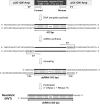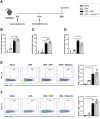A novel defined TLR3 agonist as an effective vaccine adjuvant
- PMID: 36761735
- PMCID: PMC9902914
- DOI: 10.3389/fimmu.2023.1075291
A novel defined TLR3 agonist as an effective vaccine adjuvant
Abstract
Synthetic double-stranded RNA analogs recognized by Toll-like receptor 3 (TLR3) are an attractive adjuvant candidate for vaccines, especially against intracellular pathogens or tumors, because of their ability to enhance T cell and antibody responses. Although poly(I:C) is a representative dsRNA with potent adjuvanticity, its clinical application has been limited due to heterogeneous molecular size, inconsistent activity, poor stability, and toxicity. To overcome these limitations, we developed a novel dsRNA-based TLR3 agonist named NexaVant (NVT) by using PCR-coupled bidirectional in vitro transcription. Agarose gel electrophoresis and reverse phase-HPLC analysis demonstrated that NVT is a single 275-kDa homogeneous molecule. NVT appears to be stable since its appearance, concentration, and molecular size were unaffected under 6 months of accelerated storage conditions. Moreover, preclinical evaluation of toxicity under good laboratory practices showed that NVT is a safe substance without any signs of serious toxicity. NVT stimulated TLR3 and increased the expression of viral nucleic acid sensors TLR3, MDA-5, and RIG-1. When intramuscularly injected into C57BL/6 mice, ovalbumin (OVA) plus NVT highly increased the migration of dendritic cells (DCs), macrophages, and neutrophils into inguinal lymph node (iLN) compared with OVA alone. In addition, NVT substantially induced the phenotypic markers of DC maturation and activation including MHC-II, CD40, CD80, and CD86 together with IFN-β production. Furthermore, NVT exhibited an appropriate adjuvanticity because it elevated OVA-specific IgG, in particular, higher levels of IgG2c (Th1-type) but lower IgG1 (Th2-type). Concomitantly, NVT increased the levels of Th1-type T cells such as IFN-γ+CD4+ and IFN-γ+CD8+ cells in response to OVA stimulation. Collectively, we suggest that NVT with appropriate safety and effectiveness is a novel and promising adjuvant for vaccines, especially those requiring T cell mediated immunity such as viral and cancer vaccines.
Keywords: TLR3 agonist; Th1 response; dsRNA; in vitro transcription; vaccine adjuvant.
Copyright © 2023 Ko, Cha, Lee, Bae, Ham, Lee, Kim and Han.
Conflict of interest statement
Author KK, SC, S-HL, HB, CH, M-GL and D-HK are employed by NA Vaccine Institute Research and Development Center. The remaining author declare that the research was conducted in the absence of any commercial or financial relationships that could be construed as a potential conflict of interest.
Figures




Similar articles
-
Particulate formulations for the delivery of poly(I:C) as vaccine adjuvant.Adv Drug Deliv Rev. 2013 Oct;65(10):1386-99. doi: 10.1016/j.addr.2013.05.013. Epub 2013 Jun 7. Adv Drug Deliv Rev. 2013. PMID: 23751781 Review.
-
The differences in immunoadjuvant mechanisms of TLR3 and TLR4 agonists on the level of antigen-presenting cells during immunization with recombinant adenovirus vector.BMC Immunol. 2018 Jul 28;19(1):26. doi: 10.1186/s12865-018-0264-x. BMC Immunol. 2018. PMID: 30055563 Free PMC article.
-
Aqueous extracts from cultivated Cistanche deserticola Y.C. Ma as polysaccharide adjuvant promote immune responses via facilitating dendritic cell activation.J Ethnopharmacol. 2021 Sep 15;277:114256. doi: 10.1016/j.jep.2021.114256. Epub 2021 May 29. J Ethnopharmacol. 2021. PMID: 34062250
-
A TLR3-Specific Adjuvant Relieves Innate Resistance to PD-L1 Blockade without Cytokine Toxicity in Tumor Vaccine Immunotherapy.Cell Rep. 2017 May 30;19(9):1874-1887. doi: 10.1016/j.celrep.2017.05.015. Cell Rep. 2017. PMID: 28564605
-
Adjuvant for vaccine immunotherapy of cancer--focusing on Toll-like receptor 2 and 3 agonists for safely enhancing antitumor immunity.Cancer Sci. 2015 Dec;106(12):1659-68. doi: 10.1111/cas.12824. Epub 2015 Nov 18. Cancer Sci. 2015. PMID: 26395101 Free PMC article. Review.
Cited by
-
Immunogenicity of Recombinant Lipid-Based Nanoparticle Vaccines: Danger Signal vs. Helping Hand.Pharmaceutics. 2023 Dec 23;16(1):24. doi: 10.3390/pharmaceutics16010024. Pharmaceutics. 2023. PMID: 38258035 Free PMC article. Review.
-
Immunization against nucleus pulposus antigens to accelerate degenerative disc disease in a rabbit model.Front Vet Sci. 2024 May 13;11:1382652. doi: 10.3389/fvets.2024.1382652. eCollection 2024. Front Vet Sci. 2024. PMID: 38803805 Free PMC article.
-
Identifying Key Drivers of Efficient B Cell Responses: On the Role of T Help, Antigen-Organization, and Toll-like Receptor Stimulation for Generating a Neutralizing Anti-Dengue Virus Response.Vaccines (Basel). 2024 Jun 14;12(6):661. doi: 10.3390/vaccines12060661. Vaccines (Basel). 2024. PMID: 38932390 Free PMC article.
-
A nasal vaccine with inactivated whole-virion elicits protective mucosal immunity against SARS-CoV-2 in mice.Front Immunol. 2023 Aug 31;14:1224634. doi: 10.3389/fimmu.2023.1224634. eCollection 2023. Front Immunol. 2023. PMID: 37720231 Free PMC article.
-
The Defined TLR3 Agonist, Nexavant, Exhibits Anti-Cancer Efficacy and Potentiates Anti-PD-1 Antibody Therapy by Enhancing Immune Cell Infiltration.Cancers (Basel). 2023 Dec 8;15(24):5752. doi: 10.3390/cancers15245752. Cancers (Basel). 2023. PMID: 38136298 Free PMC article.
References
-
- Morrow MP, Yan J, Pankhong P, Ferraro B, Lewis MG, Khan AS, et al. . Unique Th1/Th2 phenotypes induced during priming and memory phases by use of interleukin-12 (IL-12) or IL-28B vaccine adjuvants in rhesus macaques. Clin Vaccine Immunol (2010) 17(10):1493–9. doi: 10.1128/CVI.00181-10 - DOI - PMC - PubMed
Publication types
MeSH terms
Substances
LinkOut - more resources
Full Text Sources
Medical
Research Materials

